by Ray Linville
Is cooking with wild foods out of place in today’s modern society? Because it’s so old-fashioned, I was surprised by how many kids had entered the Wild Food Cooking Contest in Richmond County. It’s the event of the spring in Ellerbe, NC, when youth and adults show off their skills for cooking deer, moose, rabbit, beaver, squirrel, and other wild game. After the judges have scored each entry, everything is served buffet-style as a tasting party for the participants, their families and friends, and others like myself who attend to see how wild our food once was and still can be.
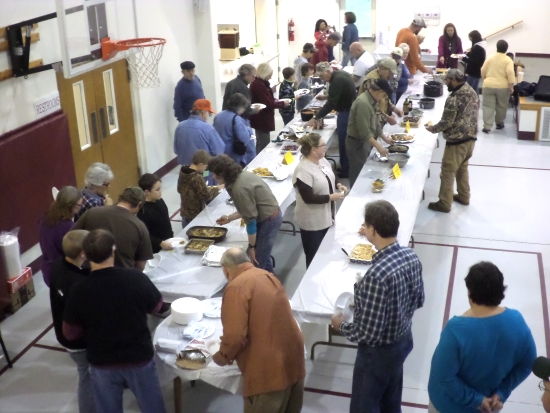
the “tasting party” of the contest.
Dishes prepared by kids age 16 and younger were the most interesting. They included teriyaki rabbit, beaver pot roast, rabbit pot pie, duck and dumplings, Eastern wild bear and wild hog sausage, and catfish stew. When I had the opportunity to sample them, each was so good that I could have made a complete meal of it.
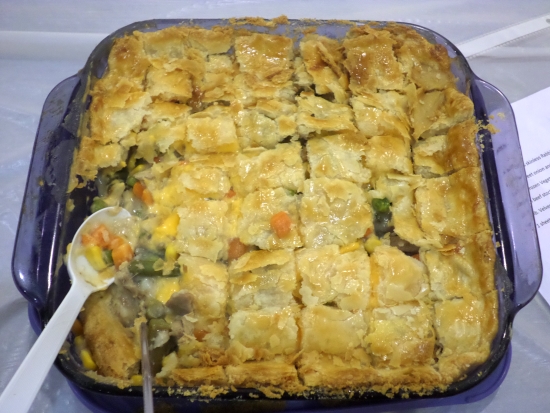
the Richmond County Wild Food Cooking Contest.
My first surprise was not so much that young people had prepared tasty food; it was that the game, fowl, or fish could not have been purchased. It had to be hunted, trapped, or caught legally or received as a gift. The actual step of cooking is only the final stage in the process and only the visible one at the contest.

agent in Richmond County, (left) and Payton Smith, winner of the youth
category, clown around by taking pictures during the event.
My next surprise was finding coot, a water bird, as an entry. I had never seen it before as a dish, and my limited experience with the bird was knowing the expressions “as bald as a coot” and “Who gives a coot?” It was the only dish that I had to think twice about trying. Although some wild food fans may adore the flavor, I’m inclined to agree with posts on the discussion board of Field & Stream that describe how difficult it is to make this bird delectable.
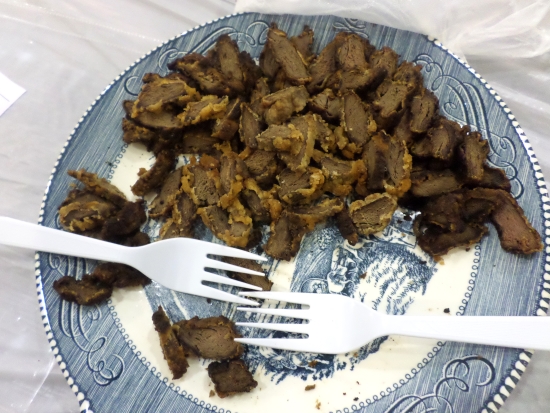
seasoned flour, and fried lightly in a pan.
In the contest, which has been held in Richmond County for 15 years, adults participate in three categories. The coot was in the category for wild fowl and fish that can also include duck, dove, reptiles, and amphibians. Just think of the fun to make a dish with snake, frog, or turtle. Another category is for game, big and small, and other mammals; entries with deer, rabbit, and similar animals compete in this group. Winning entries in these categories respectively were catfish dip (made by John Allen) and deer chili (made by Chris Stewart).
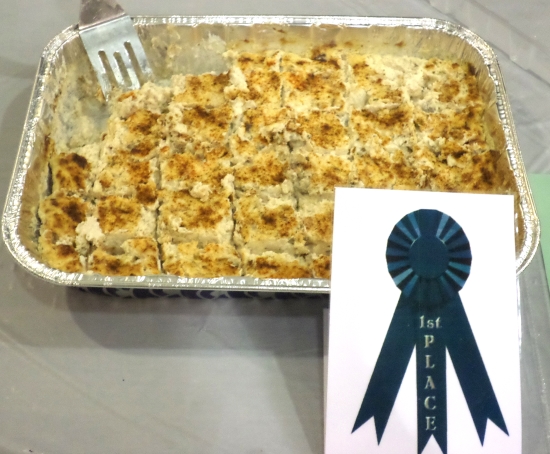
wild fowl and fish category to win.
The remaining category, which I entered, consists of foods prepared with wild fruits, nuts, and vegetation. A crowd favorite was wild blueberry muffins, although I thought my time-honored family recipe for persimmon pudding would compete well. It’s always a favorite, but it was aced out by a layer cake with Jerusalem artichokes. Although most participants live in Richmond County, the cake was entered by Carolyn Quinn of Magnolia, NC (in Duplin County). One judge commented that the cake was “so awesome,” and I have to agree that it was flavorsome (but in my heart, persimmon pudding is always a winner).
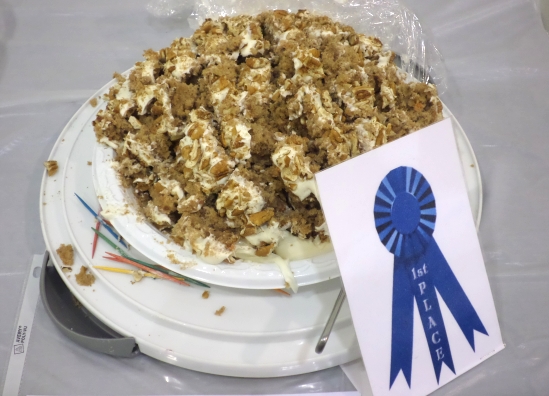
the category of fruits, nuts, and vegetation.
Each dish is also entered in the “most authentic dish” category. The judges seek to find the dish that is the most natural, such as using honey instead of sugar, being cooked over an open fire, or using cattail flour instead of wheat flour. The winner was a woodland salad prepared by Terry Sharpe. Topped with longleaf pine seeds, it included bellwort, violet leaves and flowers, wood sorrel, chickweed, and redbud flowers.
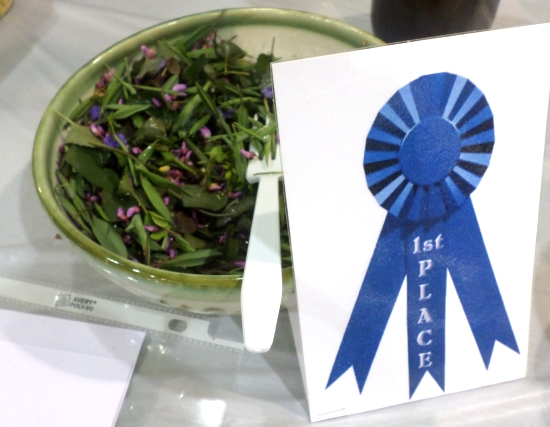
A ribbon for the most authentic dish and prizes for the winner in each category are awarded by the Sandhills Rod and Gun Club, which sponsors the contest with the Richmond County Cooperative Extension Center and Martha Faye Crafters Club (formerly Extension Homemakers). In addition, the club awards a small prize to each youth who enters a dish to encourage participation and nurture wild food cooking skills.
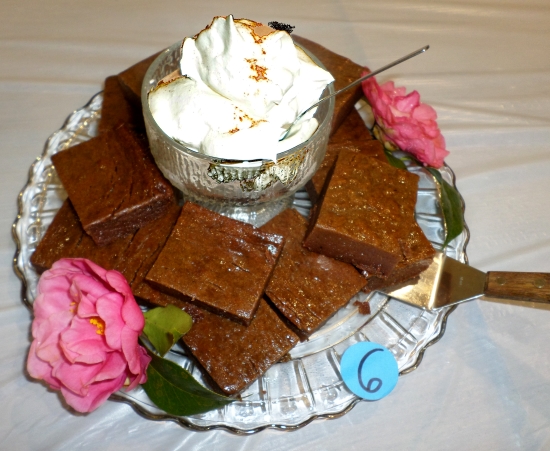
home with an empty plate) but not with the judges – the prize
for its category was awarded to the Jerusalem artichoke cake.
If you are not a hunter, trapper, or forager, you can purchase the wild foods of North Carolina at outlets such as the Asheville Wild Foods Market. (However, by purchasing, you won’t be able to enter the Richmond County Wild Food Cooking Contest!) In addition, you can join others each spring for a wild foods weekend (typically the fourth weekend in April) in Rockingham County, NC and learn about wild edible plants and collect wild foods in small groups led by an experienced forager.
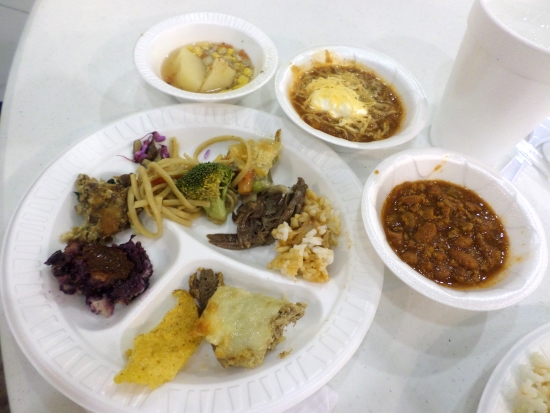
plate and needed extra bowls to sample some of the amazing dishes.
The wild foods of North Carolina are delicious and have sustained families for many generations. If you’ve never eaten bear, beaver, squirrel, or a wild plant, you’re missing the enjoyment of our land. Next spring maybe you should taste the flavor of redbud flowers. As early as the 1700s, redbud flowers were praised by explorer John Lawson, who wrote about the vegetation and wildlife of the Carolinas in the early 1700s. In his own words, the tree’s blossoms are “the best Sallad, of any Flower I ever saw. It is ripe in April and May.”

or eaten raw by Native Americans and became a favorite of
early colonial settlers as a salad ingredient.
Enjoy this recipe used by Carolyn Quinn of Magnolia, NC, to prepare the winner of the wild fruits, nuts, and vegetation category.
Jerusalem Artichoke Cake
Ingredients:
2 cups sugar
1½ cups oil
4 eggs
2 cups self-rising flour
1½ teaspoons baking soda
2 teaspoons allspice
½ teaspoon vanilla
3 cups grated Jerusalem artichokes
½ cup chopped nuts
Directions:
Prepare as you would a carrot cake. Mix sugar and oil together and add eggs. Combine flour, baking soda, and allspice together and add to sugar, oil, and egg mixture. Blend well and add vanilla, artichokes, and nuts. (Mixture will be thick). Bake at 325 degrees in two layers for 30 minutes or in tube pan for 50 minutes. (Do not overbake.) Lightly dust cake with powdered sugar and allspice or frost with cream cheese icing and top with cut nuts.
RESOURCES
North Carolina Wild Foods Weekend
_______________________________________________________________
 Ray Linville writes and lectures on regional culture, including foodways and folklife. He has taught in the N.C. Community College System as a professor of English and humanities and served on the board of the N.C. Folklore Society. Read more about Ray’s ramblings at his blog: Sights, Sounds and Tastes of the American South.
Ray Linville writes and lectures on regional culture, including foodways and folklife. He has taught in the N.C. Community College System as a professor of English and humanities and served on the board of the N.C. Folklore Society. Read more about Ray’s ramblings at his blog: Sights, Sounds and Tastes of the American South.
Leave a Reply